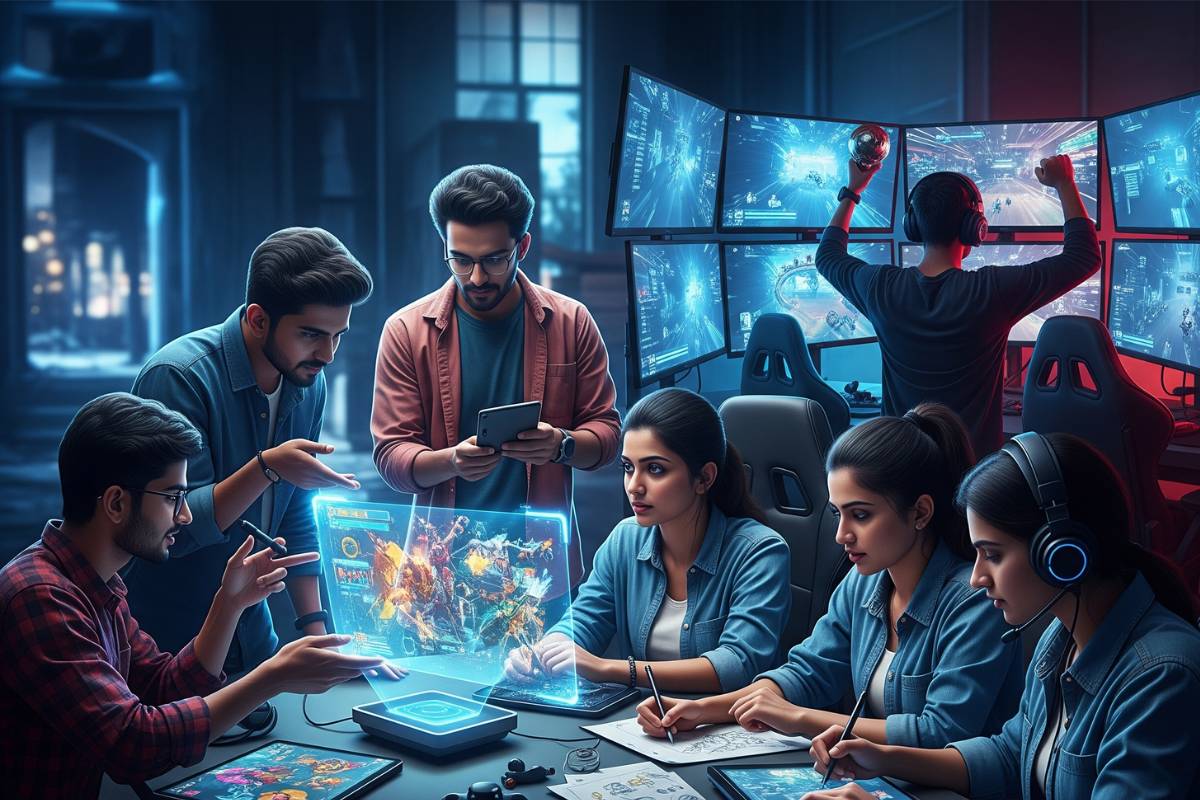Not only is the game development scene in India changing, it’s being completely rewritten. The country’s gaming ecosystem has changed in amazing ways, from small studios in basements to billion-dollar powerhouses.
The numbers tell a very interesting story. India now has more than 590 million gamers, which makes it one of the biggest gaming markets in the world. By 2029, the sector is expected to be worth $9.1 billion, and by 2034, it could be worth an incredible $60 billion. That’s not just growth; it’s a huge change.
The Mobile-First Revolution That Is Making Indian Gaming Successful
India is a mobile-first gaming market, with an amazing 96.8% of all gamers playing on smartphones or tablets. It’s not just a matter of choice; it’s also about access. Cheap smartphones and data plans have made gaming available to everyone, from big cities to small towns.
By 2025, the mobile gaming market is expected to bring in more than 60% of India’s gaming revenue. Why does this matter? It has made a one-of-a-kind ecosystem where developers know more about casual gaming psychology, retention mechanics, and freemium monetization than anywhere else.
Changes in the Market and How Players Act
Developers have never had so many chances as they do now, with India’s gaming community expected to grow to 641.2 million by 2027. The 15.2% compound annual growth rate (CAGR) through 2033 shows that the growth will last, not just be a short-term bubble.
This is what is causing this growth:
- Many people in tier-2 and tier-3 cities are using smartphones
- 5G rollout is making cloud gaming with low latency possible
- Government programs that help build digital infrastructure
- Young people with more money to spend
15 Game Development Studios That Will Change India’s Future
Nazara Technologies
- One of the first gaming companies in India, Nazara, focuses on mobile entertainment and eSports.
- The company’s range of gaming products includes sports simulation and skill-based gaming platforms.
- What makes them different: Early recognition of India’s mobile potential and smart purchases of promising studios.
Dhruva Interactive
- The best Indian AAA game developer; now part of Rockstar Games.
- Based in Bangalore, they’ve worked on some of the most well-known games in the business.
- Rockstar’s purchase of them showed that Indian studios can compete globally.
Moonfrog Labs
- Expert in community-driven gaming and social mobile games.
- Teen Patti Gold shows how traditional Indian games can be digitized.
- Key strength: Knowing how social games work and using cultural references to keep players engaged.
SuperGaming
- This studio in Pune has found a niche in multiplayer gaming, with games like MaskGun.
- Focused on competitive games that work well on mobile.
- Innovation: Cloud gaming and cross-platform integration.
99Games
- Known for making high-quality mobile games with great graphics.
- Racing and strategy games consistently perform well in app stores.
- Approach: Mixing strong visuals with playable mechanics for long-term engagement.
PlaySimple Games
- Masters of word and puzzle games, with very high engagement rates.
- Crossword and word game collections highlight a deep understanding of casual gaming.
- Key to success: Simple to learn, hard to master – great for mobile gamers.
Nodding Heads Games
- Makers of Raji: An Ancient Epic, highlighting Indian storytelling and mythology.
- Focus on story-driven games that appeal globally.
Games2win
- Expert in casual mobile games and monetization.
- Global popularity for parking and driving simulation titles.
- Core competency: Effective freemium monetization that preserves player experience.
Dream11 Interactive Games
- Expanded from fantasy sports into interactive gaming experiences.
- Market position: Leveraging India’s cricket enthusiasm for immersive digital games.
Yellow Monkey Studios
- Focus on strategy, RPGs, and AR-powered experiences.
- Innovation edge: Bringing augmented reality into everyday mobile gaming.
ReDimension Games
- Indie pioneer, celebrated for creative and innovative gameplay.
- Philosophy: Bringing together inventive mechanics and culturally-based themes.
Niku Games
- Indie studio fostering experimental and creative game development.
- Pushes unconventional gaming concepts beyond genre boundaries.
Shura Games
- Example of creative Indian gamification.
- “Spice Secrets” lets players make Indian dishes with spices.
- Cultural integration: Everyday Indian life turned into engaging games.
Dunali Games
- Indie generation studio focused on authentic Indian experiences.
- Broadens and diversifies India’s gaming portfolio with audience-focused titles.
Arjuna Studios
- Known for “Gangster Carnival” featuring Indianized carnival art.
- Artistic vision: Distinct visual aesthetics that celebrate Indian art forms.
India’s Competitive Edge: Cultural Storytelling
Indian mythology and folklore are becoming the backbone of game development. Games true to their culture are gaining worldwide attention. Raji: An Ancient Epic is proof that Indian storytelling can appeal globally.
Cultural resonance isn’t just about local acceptance – it helps Indian games stand out in the global market. When studios like Shura Games make cooking games using Indian spices or Arjuna Studios showcase carnival art styles, they’re exporting culture through gaming.
Combining Regional Languages
Bringing in regional language support is expanding gaming access. Developers are adding Hindi, Tamil, Telugu, Bengali, and more, helping more players connect at a personal level.
- Opens up games to a broader player base
- Creates stronger emotional connections between games and players
How Technology Trends Are Changing Game Development
Combining AI and Machine Learning
Modern Indian studios use AI for level design, animation, and player analytics. It’s not just about efficiency – it’s about making unique, personal gaming experiences.
- AI changes difficulty in real-time for players
- Procedural content generation means endless new gameplay
- Predictive analytics help studios with player retention
5G Infrastructure and Cloud Gaming
Deployment of 5G is driving cloud gaming with low latency. Developers can now produce richer, more complex titles for mobile without hardware limitations.
- Cloud streaming enables console-like experiences for mobile users
Combining Blockchain and NFT
Some studios are experimenting with blockchain assets and NFT integration; still early, but it’s the future of gaming tech.
The Investment Scene and Government Help
Between FY20 and FY24, the sector attracted $2.78 billion in investment, fueling studio expansion and international competitiveness.
What the Government Is Doing
Prime Minister’s “Digital India” projects are motivating developers to lead in online gaming. The Inter-Ministerial Task Force (IMTF) shows policy support for growth.
- Simplified game development regulation
- Tech company tax incentives
- Infrastructure development for digital services
Accelerators and Incubators
Programs and events like Krafton India Gaming Incubator and India Game Developer Conference (IGDC) provide mentorship, financial backing, and vital networking.
- Empowers technical skills and global market entry
- Builds developer-investor-publisher collaboration
Problems and Chances Ahead
Developing Talent
Despite growth, there’s a skill shortage in backend development and engineering – a challenge and opportunity for institutions.
- Game courses in technical schools
- Partnerships for advanced skills
- Global collaborations for knowledge-sharing
Access to Capital
Developers want easier access to venture capital and government-backed funds. More streamlined funding could further speed up growth.
International Competition
As Indian studios gain recognition, they face seasoned global competitors. This spurs innovation and demands continuous upgrades.
The Path to Global Gaming Leadership
India’s rise from gaming market to development hub is striking. Now hosting 1,888 gaming companies and employing over 130,000 people, the sector could create 2 million high-skilled jobs by 2034.
Growth is also emerging in tier-2 hubs (like Ahmedabad, Kochi, Surat, and Rajkot) due to lower costs and skilled labor.
Export Potential
Indian IP creation and export are the next big milestones. As studios develop culture-rich titles that appeal worldwide, they position India as both a market and a global content creator.
With forecasts of reaching $60 billion by 2034, Indian games are set to appear on more international platforms.
New Ideas Come from Diversity
Cultural diversity, not just technical skill, sets India apart. Developers draw from 22 official languages, hundreds of dialects, and ancient storytelling traditions.
The rise of regionally focused and culturally resonant games is more than a trend – it’s a competitive strength.
As 2025 goes on, Indian game development stands at a crossroads. Technical know-how, cultural richness, low cost, and a vibrant home market create fertile ground for growth. These 15 studios mark only the beginning – where innovation meets tradition in the digital age.
The question isn’t whether Indian game development will succeed internationally, but how soon the world will see what’s happening in studios from Bangalore, Kochi, Pune, and Hyderabad. The story isn’t just business – it’s a cultural revival, playing out on millions of screens.



















